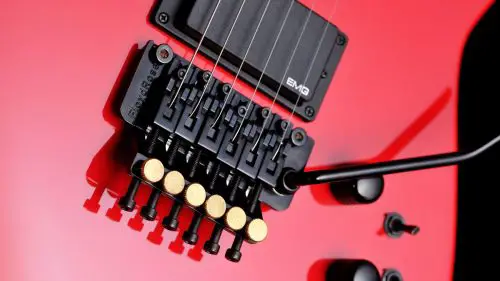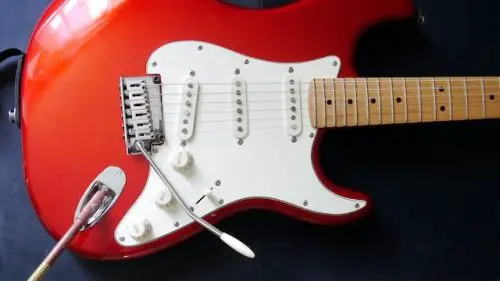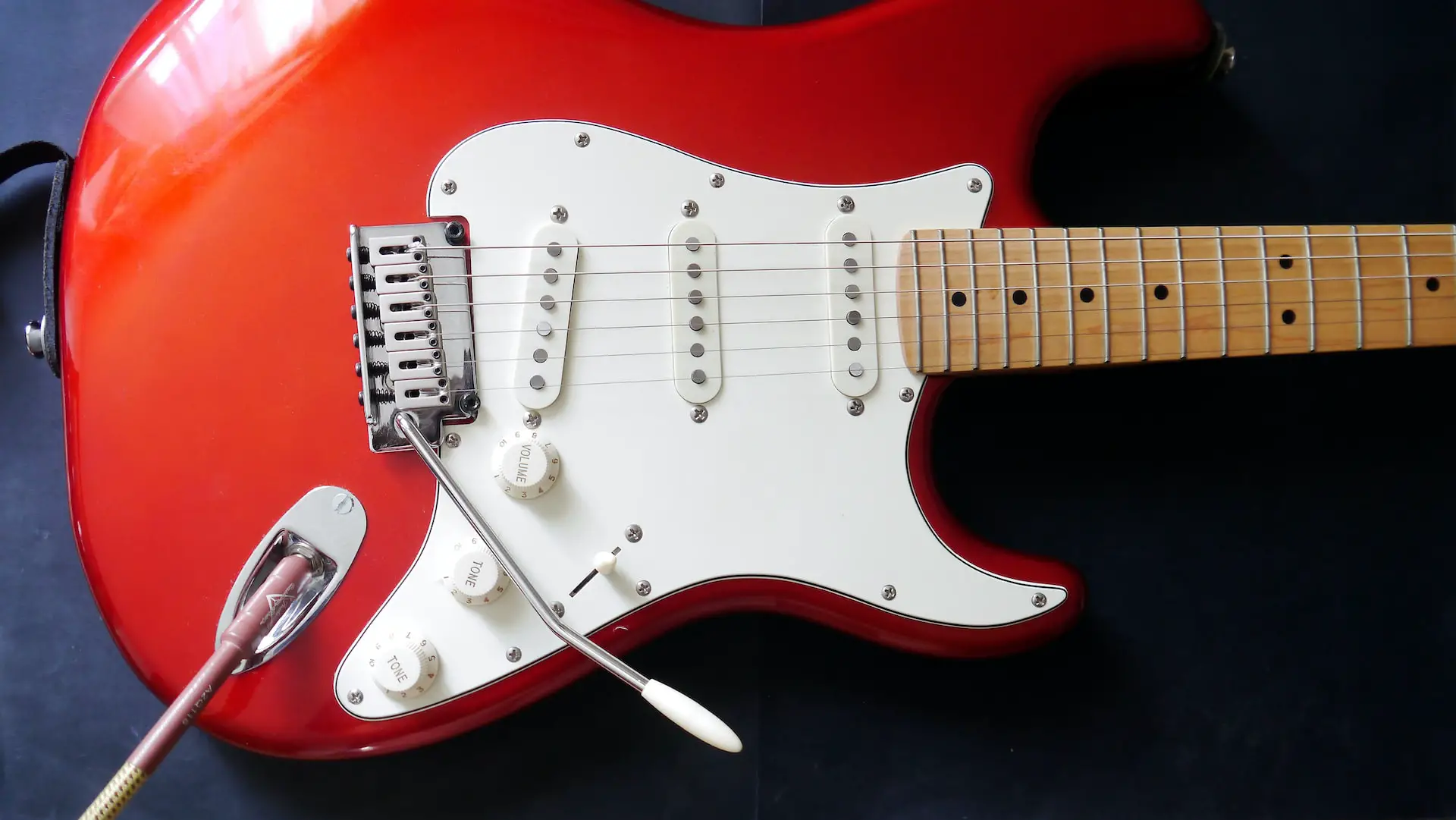A whammy bar is attached to the bridge of your guitar and will put enough tension on the strings to either reduce the stress (in a regular bridge) or reduce and increase the pressure (with a Floyd Rose bridge). Reducing the tension will create a lower pitch and tone while increasing the tension will create a higher pitch and tone.
A whammy bar is usually played in rock and metal music, and it is, therefore, necessary if you are playing that type of music. It is also used somewhat in blues. However, it is not necessarily required or often played in other types of music.
As someone who has played the guitar and bass for over fifteen years, playing with a whammy bar can be fun, and they are very easy to use once you get the hang of it.
However, playing with a whammy bar is by no means a requirement or necessary. They will not make you a better guitar player. But they can help produce some great tones, especially if you regularly play hard rock or metal.
Please keep in mind when going through this article that a lot of what is discussed here is opinion. There is nothing wrong with using a whammy bar or not using a whammy bar, regardless of the style of music that you enjoy playing. However, as they are prevalent (especially in the rock and metal genres of music), they are worth exploring in more detail.
In this article, we will go over how Whammy Bars work and what the point of them is if they are necessary, do they damage the guitar, do they break strings, and are they worth it. We will also go over the difference between a whammy bar and a tremolo arm.
We will also go over a few frequently asked questions, like what to use if you don’t have a whammy bar, whether a whammy bar works without an amp, and whether it should be removed if you don’t play it often.
How Do Whammy Bars Work & What’s The Point?

A whammy bar works by loosening or tightening the tension on a chord or note to help change the note or chord that you are playing. The point is to create a lower note or sound (or a higher note or sound if you are pulling up on the bar instead of pushing it down.
Whammy Bars are on two types of bridges, fixed and Floyd Rose bridges. A fixed bridge will only allow you to push the bar down. A Floyd Rose Bridge will allow you to push the bar down and pull it up (allowing you to create a higher sound by increasing the tension on the strings as opposed to only decreasing the pressure on the strings when you push down, as on a regular bridge).
When the Whammy Bar is pushed down, it reduces the limit of the tension on the strings by shrinking the distance of the strings between the bridge and the tuning pegs.
When the bar is let go, the bridge is supposed to return to its original position. The point of this is to create the tone and note differences in the songs you are playing.
Whammy bars are usually used in rock or metal music, primarily focusing on guitar playing and guitar solos. For example, Eddie Van Halen used a whammy bar frequently while playing in Van Halen.
Is a Whammy Bar Necessary?
While a Whammy Bar is very popular in rock and metal music, it is not necessary to own one, regardless of the style of music you wish to play. However, they can be fun to play with if you are typically playing a rock or metal style of music.
Owning a whammy bar will not make you a more skilled player. You can increase your playing skill by practicing things like string bending, hammer-ons, pull-offs, and playing harmonics.
Even when playing rock or metal, a whammy bar is not necessary. But it can be fun to use to experiment with.
Does Whammy Bar Damage Guitar?

Having a Whammy Bar on your guitar will not damage it in any way whatsoever. However, it may create an issue where you must regularly tune and retune the guitar.
Please keep in mind that the whammy bar can only work with your guitar having the proper bridge. Be it a fixed bridge (this bridge can move only one way, which is down)
or a Floyd Rose Bridge (which can move either down or up); both are designed for movement. There is no potential danger of damaging a guitar in either case.
Any guitar can theoretically have the necessary bridge installed that is compatible with a whammy bar. However, if you have limited experience in installing such things, you may run the risk of damaging the guitar if you are new to installing something like this. If this is the case, consider bringing the guitar to a technician to do this for you.
Also Read: Will Whammy Bars Detune Your Guitar (& 7 Prevention Tips)
Does Whammy Bar Break Strings?
A whammy bar will not break your guitar strings unless you pull outrageously hard on the strings. However, since using a whammy bar will continuously reduce and increase the tension on the strings, it may be necessary to tune the guitar more than you otherwise would.
Playing the guitar for a long time and continually bending and pulling strings will eventually wear them down and break them.
Therefore, your strings may wear out a bit faster if you play with a whammy bar on a regular basis. However, using a whammy bar will not cause your strings to snap.
Also Read: Loose Guitar Strings: Reasons & Best Tightening Methods
Is a Whammy Bar Worth It?
A whammy bar is worth it only if your guitar skills have reached the level necessary for it. If you are buying and installing a whammy bar just for the looks of it, I don’t think that’s worth it.
As a beginner guitarist, once you are able to refine your playing techniques, chances are you will want to upgrade to a new guitar at that point, anyway. I suggest upgrading to something with a whammy bar after you have perfected these other skills (assuming you want to continue playing rock or metal). Playing with a whammy bar can be fun, but it will not make you a better guitar player.
The parts themselves to install the whammy bar yourself will be approximately $40.00. However, if you are paying someone to install it, you may have to spend another couple hundred dollars. If you install a Floyd Rose bridge, you would be spending at least $90.00.
Some guitars may need additional work to have a whammy bar installed, such as removing the old bridge and drilling new holes to install the new one to which your whammy bar will be attached.
If this is the case, it may be necessary to have the guitar repainted. The costs to remove your guitar’s hardware (pickups, bridge, knobs, neck, etc.) to have it repainted will probably cost another couple of hundred dollars more.
Additionally, if you do not like playing rock or metal, it is certainly not worth getting a whammy bar since it is primarily used in this style of music.
However, if you like metal or rock and are just starting, I would advise against paying for a whammy bar to be installed on a guitar that does not have one. You can advance much quicker as a guitar player by focusing on fundamental techniques like hammer-ons, pull-offs, and string bending.
What’s The Difference Between a Whammy Bar and a Tremolo Arm?
There’s no difference between Whammy Bar and Tremolo Arm – they are different names with the same function.
Leo Fender (of Fender Guitars) decided to call his whammy bar a tremolo arm, and the term has stuck. It is popular on the Stratocaster.
Both the whammy bar and the tremolo arm will do the same thing, which is reducing and or increasing the pressure on your strings to create a different pitch.
What Can I Use if I Don’t Have a Whammy Bar?
1. The Neck
You can press the guitar’s neck away from you (assuming the guitar strap is around your neck as you are playing it). This will help to reduce the tension in the strings and help to create the same sound a whammy bar makes by temporarily decreasing the pressure on your strings.
Just a fair warning, please do so gently, and at your own risk, as too much tension this way can cause damage to the neck of the guitar.
2. Whammy Pedal
You can play with a whammy pedal if you do not have a whammy bar. This will also keep your hands free as well. Just press the pedal with your foot when you want to add the whammy effect.
3. Substitute other techniques
You can always play harmonics, along with doing other types of slides and hammer-ons and pull-offs, and string bending as well in place of the whammy bar to create another effect. Mastering these techniques will make you a better player than playing with the whammy bar would, anyhow.
FAQs
Q: Does a Whammy Bar Work Without an Amp?
The Whammy Bar will work without plugging the guitar into the amplifier. However, the sound will be a low enough volume that it would not be heard very well anyhow.
Playing hard rock or metal is usually played through a guitar amplifier anyway, as it is generally played loudly with a distorted tone. So while it is technically possible to play a whammy bar without an amplifier, it would only be heard well (if at all) with it.
Q: Should I Remove the Whammy Bar?
The short answer is that it depends. If you are removing only the bar itself and your bridge and the rest of the system is set up in a ‘down only’ mode (meaning you can only push the bar down, and it can not increase the tension on the strings, only decrease it, (this is common for Stratocasters) then you can remove the bar itself, and you will be fine. You will essentially be playing with a fixed bridge at this point, as it does not float.
If you have a floating system, like the Floyd Rose system, that lets you both increase and decrease the stress on the stings, removing the whammy bar is still possible. However, your bridge will still float and will most likely not be as stable.
If you are not a fan of playing complex rock or metal, and your guitar already has a fixed bridge, you should probably remove the whammy bar. Your bridge will stay stationary, and you should have no issues keeping your strings in tune.
However, if you have a Floyd Rose bridge, it may float, as it can move both ways. You can still remove the whammy bar itself and play without it. However, you may find your strings stay in tune a little bit better with a fixed bridge system.
Conclusion
In conclusion, we covered how Whammy Bars work and what the point of them is. We also discussed if they are necessary or not, if they damage the guitar or not, do they break strings or not, and whether or not they are worth it. We also covered the difference between a whammy bar and a tremolo arm.
We also covered a few frequently asked questions about what to use if you don’t have a whammy bar, whether it will work without an amp, and whether it should be removed if you don’t often use it.
Please remember that a whammy bar is not a requirement. Using a whammy bar regularly will not make you a better player. It just adds a new effect to your playing that is popular with playing rock and metal music. However, there is no reason you could not use a whammy bar to play other genres of music as well.
However, if you like it and have fun with it, then feel free to use it. Having fun and being creative is the best reason to play an instrument. You may find that you enjoy it.





